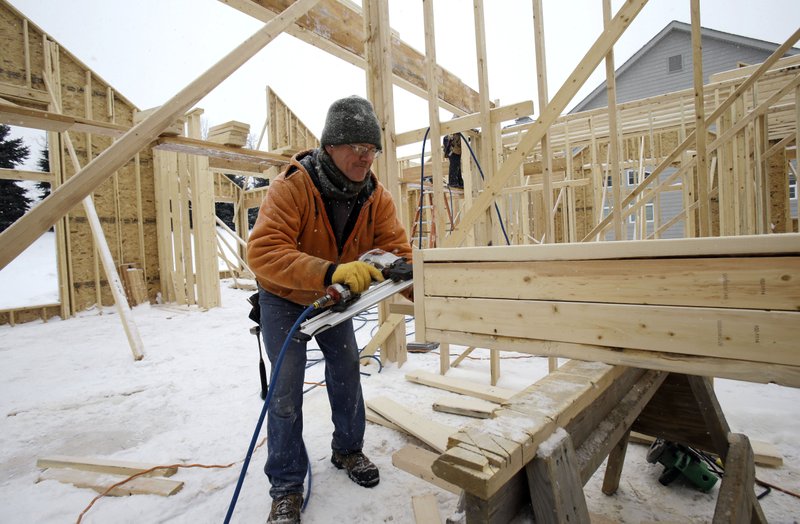WASHINGTON -- The U.S. economy suffered a smaller setback in the first quarter than previously estimated as American consumers spent a little more.
The economy, as measured by the gross domestic product, shrank at a seasonally adjusted annual rate of 0.2 percent from January through March, the Commerce Department said Wednesday. That's better than last month's estimate of a 0.7 percent decrease.
Harsh winter weather slowed spending by keeping consumers away from shopping malls and auto dealerships. The trade deficit ballooned, slicing growth by the most since 1985 as exports fell and imports rose.
"What we are seeing here does validate the story that the first-quarter weakness was transitory," said Michael Feroli, chief U.S. economist at JPMorgan Chase & Co. in New York. "The consumer is coming back to overall decent growth."
Consumers stepped up their spending in May, and home sales are climbing -- signs that the economy is back on track. In addition, many of the head winds the economy faced in the first quarter -- from an increase in the dollar's value to spending cutbacks by oil drillers -- are fading.
"Growth should remain near 3 percent in the second half of the year as the dampening effects of a strong dollar and oil industry slump fade," Sal Guatieri, an economist at BMO Capital Markets, said in a note to clients.
Forecasting firm Macroeconomic Advisers predicts growth will reach 2.7 percent in the second quarter. And many economists agree with Guatieri that growth should reach 3 percent in the second half of the year.
Still, that would leave growth in the first half at a weak 1.2 percent annual rate. The economy appears to be on track for another year of modest 2 percent to 2.5 percent growth.
That's far below the optimism at the beginning of the year, when lower oil prices and healthy hiring led many economists to forecast growth above 3 percent. The economy hasn't reached that level in a decade.
The median projection of economists surveyed by Bloomberg from June 5-10 was for expansion at a 2.5 percent rate from April through June and an average of 3 percent growth in the last half of the year.
Exports were hammered in the first quarter by a sharp rise in the dollar's value, which makes U.S. goods more expensive overseas. The dollar has strengthened 15 percent in the past year compared with a basket of other currencies.
That also makes imports cheaper and better able to compete with U.S.-made goods. Imports increased 7.1 percent in the first quarter, while exports fell 5.9 percent. That widened the trade gap, cutting nearly 1.9 percentage points from growth, the most in 30 years.
A trade dispute at West Coast ports also contributed to the disparity, but it has since been resolved. And the dollar's value has leveled off since March, suggesting its effect will lessen.
Oil and gas companies, meanwhile, sharply cut back on drilling and exploration activity and spent much less on steel pipe and other equipment. Business investment in structures, which include oil wells, dropped by nearly 19 percent, the most in four years. Those cutbacks occurred in the wake of last year's steep drop in oil prices but have since slowed and should stop weighing on growth in the second half of the year, analysts forecast.
Americans saved more in the first quarter, aided by lower gasoline prices and an increase in hiring. The saving rate rose to 5.4 percent from 4.7 percent in the fourth quarter, the highest in more than two years. Consumer-spending growth slipped to 2.1 percent, down from 4.4 percent in the final three months of last year.
But since then, there have been signs that Americans are opening their wallets again. Consumer spending accounts for 70 percent of economic activity.
"The slowing in consumer spending looks more like a pause that refreshes ... rather than the start of a weakening trend," Guatieri said.
Sales at retail stores and restaurants jumped 1.2 percent in May, as shoppers spent more on clothes, building materials and furniture.
Consumers are also willing to spend more on major purchases, potentially a sign of growing confidence in what has been a stop-and-start expansion. Auto sales jumped in May to the highest level in nearly a decade.
And the biggest purchase of all -- a home -- is becoming reality for more people. Sales of previously owned homes are on track for their best year since 2007. New-home sales last month reached their highest level since February 2008.
Wednesday's figure is the last of three initial estimates of first-quarter growth. The government will revise the figure yet again on July 30 as part of more comprehensive annual changes. That revision may also include changes to the seasonal adjustments the government uses, which could make the change more dramatic.
The first estimate of second-quarter GDP is also scheduled for July 30.
Information for this article was contributed by Christopher S. Rugaber of The Associated Press and by Shobhana Chandra and Kristy Scheuble of Bloomberg News.
Business on 06/25/2015
